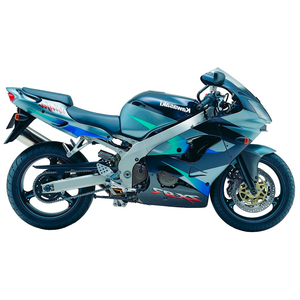Kawasaki ZX-9R Ninja [2000–2002]: A Timeless Open-Class Contender
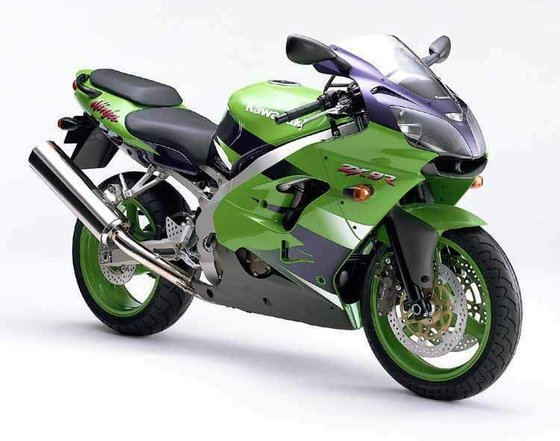
The Kawasaki ZX-9R Ninja, produced from 2000 to 2002, remains a defining machine in the open-class sportbike segment. While newer models have since dominated headlines, the ZX-9R’s blend of raw power, rider-friendly ergonomics, and chassis refinements make it a compelling choice even today. Having recently spent time with a well-maintained 2002 example, it’s clear why this generation of the Ninja still commands respect among enthusiasts.
Engine Performance: Brutal Power Meets Refined Delivery
At the heart of the ZX-9R lies its 899cc inline-four engine, a masterpiece of late-’90s engineering that Kawasaki refined for the new millennium. With 143–144 HP (105–106 kW) peaking at 11,000 RPM and 101 Nm (74.4 lb-ft) of torque at 9,000 RPM, this engine delivers a thrilling yet manageable powerband. The moment you twist the throttle, the Keihin 40mm carburetors respond with a satisfying growl, funneling air through an aggressive Ram Air scoop that adds urgency as speeds climb.
What stands out isn’t just the top-end rush—though hitting 280 km/h (174 mph) is electrifying—but the mid-range punch. The 12.2:1 compression ratio and revised cam profiles ensure strong pull from 6,000 RPM, making overtaking or carving through mountain passes effortless. The six-speed gearbox slots precisely, though the clutch requires a firm hand in stop-and-go traffic. For a carbureted bike, cold starts are surprisingly civil, thanks to the enriched choke circuit.
Chassis and Handling: Stability Without Sacrifice
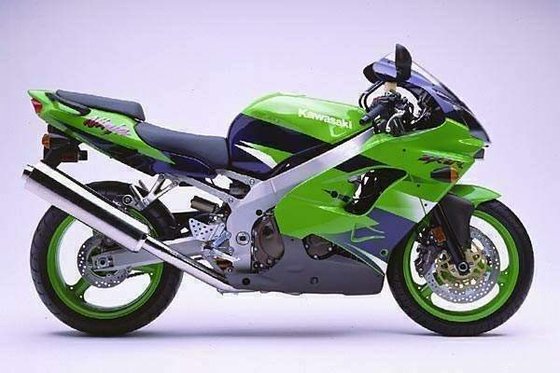
Kawasaki’s aluminum twin-spar frame underwent critical updates during this generation. By 2002, the steering head was reinforced, the swingarm gained a hexagonal cross-section, and front axle diameter increased by 5 mm. These changes paid dividends: the ZX-9R feels planted at high speeds yet nimble enough for tight corners.
The 46mm conventional forks and Uni-Trak rear shock offer preload, compression, and rebound adjustments. Dialing in a stiffer front and adding rear ride height (via shims) sharpened turn-in without sacrificing stability. The Bridgestone Battlax tires—120/70-ZR17 front and 190/50-ZR17 rear—provide ample grip, though swapping to a 180-section rear could quicken steering further. Ground clearance is generous, with only the hero knobs grazing pavement at extreme lean angles.
Braking performance saw significant upgrades by 2002. The switch to Nissin four-piston calipers biting on 310mm discs transformed feel and power. Two-finger lever pulls deliver progressive bite, inspiring confidence when scrubbing speed before hairpins.
Design and Ergonomics: Function Meets Comfort
The ZX-9R’s dual-headlight fairing and Ram Air intake scream ’00s sportbike aesthetic, but it’s the practicality that impresses. The windscreen deflects airflow well at highway speeds, and the 810–827 mm (31.9–32.5 in) seat height accommodates riders of varying statures. Unlike today’s race-replicas, the Ninja’s ergonomics strike a balance—pegs are rear-set but not punishing, and the bars offer a slight forward lean.
Color options—Kawasaki’s signature green, red, and blue—pop even decades later. The analog tach and digital speedometer are legible, though the lack of a fuel gauge (relying on a petcock reserve) feels quaint. Storage under the passenger seat fits a wallet or gloves, a nod to the bike’s sport-touring potential.
Competition: Holding Its Own Against Legends
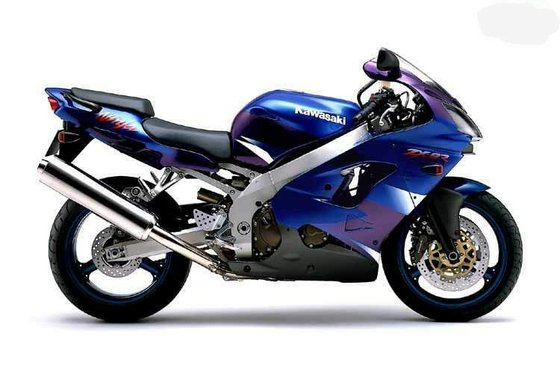
In the early 2000s, the ZX-9R faced fierce rivals:
- Yamaha YZF-R1 (2000–2002): Lighter (177 kg dry) and packing 150 HP, the R1 was sharper on track. However, its aggressive ergonomics and twitchy chassis made it less forgiving on the street.
- Honda CBR929RR FireBlade: Honda’s 929cc inline-four emphasized agility. While its 152 HP trumped the Kawasaki, the CBR’s shorter wheelbase and stiffer ride appealed more to hardcore riders.
- Suzuki GSX-R1000 (2001–2003): The Gixxer’s 160 HP engine and minimalist design redefined the class. Yet its race-focused setup lacked the ZX-9R’s versatility for long rides.
The Ninja’s ace was its balance. It surrendered some outright performance to rivals but countered with stability, comfort, and a broader powerband. Touring riders praised its 19-liter (5.0-gallon) tank and smooth engine, while weekend warriors appreciated its adjustability.
Maintenance: Keeping the Ninja Thriving
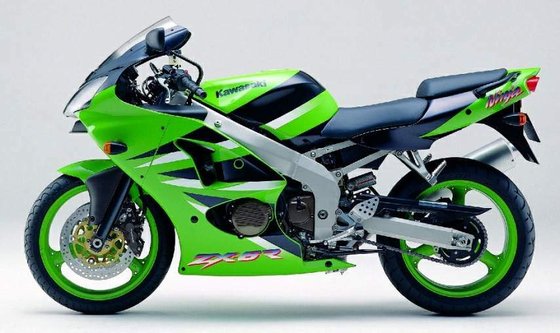
Owning a 20-year-old sportbike demands diligence. Here’s what to prioritize:
Key Service Intervals
- Valve Clearances: Inspect every 26,000 km (16,000 miles).
- Intake: 0.15–0.24 mm (0.006–0.009 in)
- Exhaust: 0.22–0.31 mm (0.009–0.012 in)
- Oil Changes: Use SAE 10W-40 (3.3L with filter). Replace every 5,000 km (3,100 miles).
- Coolant: Flush every 2 years with Kawasaki-approved ethylene glycol.
- Chain: Clean and lubricate every 500 km (310 miles). Replace worn 110-link chains and 16/41 sprockets promptly.
Common Upgrades
- Spark Plugs: Stick with NGK CR9EK (gap: 0.7 mm) for reliable ignition.
- Brake Pads: Swap to sintered pads for improved bite.
- Suspension Fluid: Refresh fork oil (SAE 10W) annually for consistent damping.
MOTOPARTS.store Recommendations
- OEM-Spec Filters: Ensure optimal engine protection.
- High-Performance Chains: D.I.D. or RK X-ring chains reduce maintenance frequency.
- Tire Pressure Monitors: Track 2.5 bar (36 psi) front and 2.9 bar (42 psi) rear on the go.
Conclusion: A Legacy of Versatility
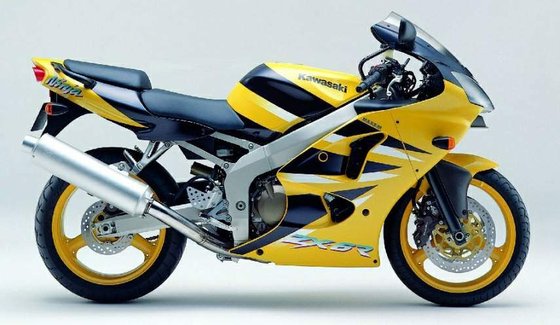
The 2000–2002 Kawasaki ZX-9R Ninja isn’t just a relic—it’s a testament to an era when sportbikes balanced track prowess with real-world usability. Its engine thrills without intimidating, its chassis adapts to rider input, and its design ages gracefully. For those seeking an open-class machine that rewards skill without punishing inexperience, the ZX-9R remains a standout. And with MOTOPARTS.store’s extensive catalog, keeping this Ninja at peak performance is simpler than ever.
Whether you’re resurrecting a garage find or optimizing a beloved ride, the ZX-9R deserves its place in the pantheon of greats. Twist the throttle, and let that inline-four howl—it’s a sound that never gets old.




Specifications sheet
| Engine | |
|---|---|
| Stroke: | Four-stroke |
| Starter: | Electric |
| Ignition: | Digital with Kawasaki Throttle Responsive Ignition Control (K-TRIC) |
| Max power: | 105 kW | 141.0 hp |
| Max torque: | 101 Nm |
| Fuel system: | 4x 40mm Keihin CVRD40 carburetors |
| Max power @: | 11000 rpm |
| Displacement: | 899 ccm |
| Max torque @: | 9000 rpm |
| Bore x Stroke: | 75 x 50.9 mm |
| Configuration: | Inline |
| Cooling system: | Liquid |
| Compression ratio: | 12.2:1 |
| Number of cylinders: | 4 |
| Dimensions | |
|---|---|
| Wheelbase: | 1415 mm (55.7 in) |
| Dry weight: | 186 |
| Wet weight: | 202 |
| Seat height: | 810-827 mm (31.9-32.5 in) adjustable |
| Overall width: | 747 mm (29.4 in) |
| Overall height: | 1152 mm (45.4 in) |
| Overall length: | 2058 mm (81.0 in) |
| Ground clearance: | 158 mm (6.2 in) |
| Fuel tank capacity: | 19 L (5.0 US gal) |
| Drivetrain | |
|---|---|
| Final drive: | chain |
| Chain length: | 110 |
| Transmission: | 6-speed |
| Rear sprocket: | 41 |
| Front sprocket: | 16 |
| Maintenance | |
|---|---|
| Rear tire: | 190/50 z-17 |
| Engine oil: | 10W40 |
| Front tire: | 120/70 z-17 |
| Idle speed: | 1100 ± 50 rpm |
| Brake fluid: | DOT 4 |
| Spark plugs: | NGK CR9EK |
| Spark plug gap: | 0.7 |
| Coolant capacity: | 2.9 |
| Forks oil capacity: | 0.906 |
| Engine oil capacity: | 3.3 |
| Engine oil change interval: | Every 5000 km or 2 years |
| Valve clearance (intake, cold): | 0.15–0.24 mm |
| Valve clearance check interval: | 24,000 km |
| Valve clearance (exhaust, cold): | 0.22–0.31 mm |
| Recommended tire pressure (rear): | 2.9 bar (42 psi) |
| Recommended tire pressure (front): | 2.5 bar (36 psi) |
| Additional Notes | |
|---|---|
| Color options: | Red, blue, green |
| Front tire (2000-2001): | 180/55 ZR17 |
| Front brake (2000-2001): | 6-piston Tokico calipers |
| Chassis and Suspension | |
|---|---|
| Frame: | Aluminum twin-spar |
| Rear brakes: | Single 220mm disc, 1-piston caliper |
| Front brakes: | 2x 310mm discs, 4-piston Nissin calipers |
| Rear suspension: | Uni-Trak piggy-back monoshock, preload, compression, and rebound damping adjustable |
| Front suspension: | 46mm RWU forks, preload, compression, and rebound adjustable |
| Rear wheel travel: | 135 mm (5.3 in) |
| Front wheel travel: | 120 mm (4.7 in) |



